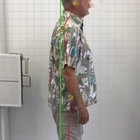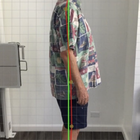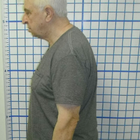Chiropractic Treatment in Mexico
Search and Compare the Best Clinics and Doctors at the Lowest Prices for Chiropractic Treatment in Mexico

Find the best clinics for Chiropractic Treatment in Mexico
With Medijump you can browse 2 facilities offering Chiropractic Treatment procedures in Mexico. The cheapest price available is $69 in Cancun. And for the cheapest price globally, prices start from $3 in Indonesia.
Chiropractic Treatment in Cancun
Price: $ 69
Indonesia offers the best prices Worldwide
Price: $ 3
From 8 verified reviews
Henry Beltran, 25 January 2020
Extremely clean, quiet and very spacious rooms, excellent service
MKSpinehealth, can be found in Diego Rivera, Tijuana, Mexico and offers its patients Chiropractic Treatment procedures as well as 23 other procedures, across 1 different procedure categories. At present, there is no pricing information for Chiropractic Treatment procedures at MKSpinehealth. The pricing information is quite specialised, so it's only available on request, and the average price is around $69. The lead specialist at the Hospital will be carrying out all the treatments, and MKSpinehealth has several accreditations, including: CMOT - Consejo Mexicano de Ortopedia y TraumatologíaCMT - Colegio Medico de Tijuana
- Home
- Mexico
Compare Before & After Photos of _procedure_photos.phpChiropractic Treatment


Full-side view


Full-side view


Full-side view


Full-side view
WHY US?
At Medijump, we're making medical easy. You can search, compare, discuss, and book your medical all in one place. We open the door to the best medical providers worldwide, saving you time and energy along the way, and it's all for FREE, no hidden fees, and no price markups guaranteed. So what are you waiting for?

Free

Best Price

Widest Selection

Risk-Free
What you need to know about Chiropractic Treatment in Mexico

Chiropractic treatment is a type of procedure where a trained and licensed practitioner (chiropractor) uses their hands to help relieve problems with the joints, muscles, and bones. It is considered a type of complementary and alternative medicine (CAM), meaning it is not a conventional medical treatment. Sometimes, the procedure is used in conjunction with conventional medical treatment.
Chiropractic treatment is mainly used to help relieve painful muscles and joints, such as back pain, shoulder pain, neck pain, elbow pain, and pain from osteoarthritis. The goal of the treatment is to reduce nerve irritability, improve functionality, and restore or increase range of motion in the affected area. Detailed information about the specific chiropractic protocols in will be provided by the clinic.
What is the cost of Chiropractic Treatment?
One of the key factors that influence your decision to undertake Chiropractic Treatment in will likely be the cost. Prices can change depending on your condition, the number of sessions, and the chiropractor's charges. Session costs can be from 30 to hundreds of dollars (intouchchiropractic). Some insurances can cover chiropractic costs, so check your insurance before booking a clinic visit.
What does a Chiropractic Treatment Procedure Involve?
At the initial appointment, your symptoms will be assessed using lab tests or diagnostic imaging to determine if chiropractic treatment is suitable and what techniques are likely to help your specific condition.
During the procedure, you will be asked to lie down in a specific position on a chiropractic table. Then, the chiropractor may use different techniques to treat problems with joints and muscles, including:
-
Spinal manipulation or chiropractic adjustment (the chiropractor uses their hands to apply controlled, sudden force to the bones, muscles, and joints in and around the spine). Gradually moving your joints into different positions.
-
Short, sharp thrusting movements in the affected area.
-
Stretching or pulling your muscles in different directions.
Although some people experience small discomfort, chiropractic treatment is usually not painful.
How Long Should I Stay in Mexico for a Chiropractic Treatment Procedure?
You can leave the clinic or hospital straight away after the treatment session. You should also be able to travel on the same day. However, it is recommended that you stay in Mexico for at least a day before traveling to give your body a little time to fully recover. Since chiropractic treatment may require more than one session, you may need to attend six to 12 sessions. You have the choice to make multiple travels to Mexico or stay for the whole treatment (around 6 weeks).
What's the Recovery Time for Chiropractic Treatment Procedures?
The recuperation period following a Chiropractic Treatment can greatly differ based on your unique health status and the treatment regimen suggested by your chiropractor. Some patients might notice immediate improvement post a single session, while others might require several sessions spanning weeks to discern notable enhancements. Post-procedure, you might experience a slight discomfort, rigidness, or fatigue.
What sort of Aftercare is Required for Chiropractic Treatment Procedures?
Chiropractic Treatment is an ongoing process; maintaining benefits and preventing symptom recurrence requires adhering to lifestyle, exercise, and dietary recommendations from your chiropractor. Follow-up visits are crucial for tracking progress, making adjustments, and providing continuous pain relief. Depending on your health, regular exercises or physiotherapy may also be recommended.
What's the Success Rate of Chiropractic Treatment Procedures?
Chiropractic Treatment has proven highly effective for conditions such as lower back pain, neck pain, and headaches. The treatment may also improve other conditions, such as osteoarthritis and fibromyalgia. Research suggests that spinal adjustments, in conjunction with lifestyle changes, can significantly improve overall wellness.
Most patients report high satisfaction after chiropractic treatments, with many experiencing notable pain relief. Nevertheless, the success of Chiropractic Treatment can hinge on factors like the specific health issue treated, the competence of the chiropractor, and the patient's adherence to post-treatment care recommendations.
Are there Alternatives to Chiropractic Treatment Procedures in Mexico?
The alternative to chiropractic treatment depends on your specific condition, so it is best to talk to your doctor before undergoing anything. Alternative treatments that can provide comparable pain relief and improve physical functionality include physical therapy, acupuncture, massage therapy, and regular exercise.
What Should You Expect Before and After the Procedure
Before the Chiropractic Treatment, your chiropractor carries out an exhaustive assessment encompassing a physical check-up and if necessary, diagnostic imaging tests. Thereafter, your healthcare history and present health conditions are reviewed to formulate a bespoke treatment strategy.
After the procedure, transient discomfort in treated regions is typical but should subside within 24 hours. Most patients depart the clinic feeling improved; the pain should be relieved, nerve irritability should be reduced, the functionality should be improved, and the range of motion in the affected area should be restored. In succeeding appointments, your chiropractor will monitor progress and adjust the treatment scheme as required.
What are the Potential Risks of Chiropractic Treatment?
While Chiropractic Treatment is safe when performed by a trained chiropractor, like any medical treatment, it does carry some potential risks. It's important to note that the majority of patients experience no serious adverse effects and find their treatment comfortable.
There are, various minor side effects and some rare but serious risks to chiropractic treatment, including:
-
Pains and aches
-
Tiredness
-
Stiffness
-
Stroke
-
Herniated or slipped disk
-
Spinal cord injury.
Whilst the information presented here has been accurately sourced and verified by a medical professional for its accuracy, it is still advised to consult with your doctor before pursuing a medical treatment at one of the listed medical providers
No Time?
Tell us what you're looking for and we'll reachout to the top clinics all at once
Enquire Now

Popular Procedures in Mexico
Prices Start From $400

Prices Start From $21

Recommended Medical Centers in Mexico for Chiropractic Treatment

- Interpreter services
- Translation service
- Religious facilities
- Medical records transfer
- Medical travel insurance
- Health insurance coordination
- TV in the room
- Safe in the room
- Phone in the room
- Private rooms for patients available

- Interpreter services
- Translation service
- Religious facilities
- Medical records transfer
- Medical travel insurance
- Health insurance coordination
- TV in the room
- Safe in the room
- Phone in the room
- Private rooms for patients available

- Interpreter services
- Translation service
- Religious facilities
- Medical records transfer
- Medical travel insurance
- Health insurance coordination
- TV in the room
- Safe in the room
- Phone in the room
- Private rooms for patients available

- Interpreter services
- Translation service
- Religious facilities
- Medical records transfer
- Medical travel insurance
- Health insurance coordination
- TV in the room
- Safe in the room
- Phone in the room
- Private rooms for patients available

- Interpreter services
- Translation service
- Religious facilities
- Medical records transfer
- Medical travel insurance
- Health insurance coordination
- TV in the room
- Safe in the room
- Phone in the room
- Private rooms for patients available

- Interpreter services
- Translation service
- Religious facilities
- Medical records transfer
- Medical travel insurance
- Health insurance coordination
- TV in the room
- Safe in the room
- Phone in the room
- Private rooms for patients available

- Interpreter services
- Translation service
- Religious facilities
- Medical records transfer
- Medical travel insurance
- Health insurance coordination
- TV in the room
- Safe in the room
- Phone in the room
- Private rooms for patients available

- Interpreter services
- Translation service
- Religious facilities
- Medical records transfer
- Medical travel insurance
- Health insurance coordination
- TV in the room
- Safe in the room
- Phone in the room
- Private rooms for patients available
Chiropractic Treatment in and around Mexico
About Mexico
The Country of Mexico forms a part of the North American continent and lies directly south of the United States and is the fifth largest country in the Americas. It comprises 31 states and a Federal District. The capital of Mexico City lies in the Federal District. Mexico is dominated by several mountain ranges and the more well-known ones are the Sierra Madre Oriental and the Sierra Madre Occidental. It is famous for its amazing beaches, and the best-known Latin American pyramids include the Pyramid of the Sun and the Pyramid of the Moon at Teotihuacán in central Mexico,
Mexico ranks among the top five locales for medical tourism worldwide, consistently attracting those seeking not only medical care but luxurious, boutique-styled facilities for recovery as well. The distinct appeal to choosing Mexico as a destination for medical procedures is not solely based on the accommodation standards, but also the notably lower costs contrasted with those in the United States. With a price tag that usually amounts to 70-80% less than what you'd expect to pay in the US for the same procedure, it's no wonder why Mexico is such an attractive option for medical tourists.
In terms of the economic value, medical tourism in Mexico has proven to be no small industry. According to the data gathered in 2016, the industry is worth a whopping $4.8 Billion. Moreover, it is not an underused resource, as can be seen in the influx of medical tourists that the country welcomes each year. An astonishing 1 million individuals travel to Mexico annually, seeking different varieties of treatments and procedures.
Geographically, it's noted that the majority of these medical tourists hail from nearby US states. In fact, states that border Mexico, such as California, Texas, and Arizona, make up approximately 70% of the medical tourists that arrive in Mexico.
Tijuana, Cancun, Mexicali, and Monterrey are some of the more popular cities in Mexico for medical tourism and the flowing procedures:
- Dental treatments including dental surgery
- Plastic and Cosmetic Surgery
- Bariatric Surgery
- Other medical procedures like dermatology, orthopedics, gynecology, and ophthalmology.
Popular Parts of Mexico
Six Cities in Mexico that should be on your itinerary:
- Mexico City – This enormous capital city is the most populous city on the North American continent. The metropolitan area of the city is home to a staggering 21.2 million people. El Zocalo, the main public square is a famous landmark in Mexico City. It is also a UNESCO World Heritage site.
- Cancun –Is a major resort city with turquoise blue waters and striking white sandy beaches. It has a population of about 628,000 people. You can take day trips to the Mayan ruins, the unspoiled jungle habitats of Coba, and Chichen Itza from Cancun.
- San Miguel de Allende –Is one of the most popular cities in Mexico. The must-visit sites in this city are the San Miguel Arcangel Parish, the archaeological zone of Canada la Virgen, and the handicraft market.
- Guadalajara – It’s the second largest city in Mexico and has a population of 5.1 million. The city has a more relaxed feel and a distinctly Mexican flavor. The historic center is impressive with a cathedral and colonial architecture. Guadalajara Cathedral, Instituto Cultural de Cabanas, and the Expiatory Temple are famous sights to visit.
- Oaxaca – Is a southern Mexican city and is situated in a valley. It is home to 4.2 million inhabitants. Oaxaca Cathedral, Zocalo and Mercado Benito Juarez, and The Rufino Tamayo Museum are a few of the interesting places to see in this city.
- Tijuana – Is a border city in Mexico and shares its border with California. Because of its location, this city is very popular with American medical tourists. The Avenida Revolucion is the main street and is lined with Bars and Restaurants. Popular landmarks include Jai Alai Fronton Palace, Centro Cultural Tijuana, and Estadio Caliente. It has a population of 1.3 million people.
Other important cities are Merida, Acapulco, Puebla City, Taxco Puerto Vallarto, and Playa del Carmen.
Weather and Climate in Mexico
Mexico, in its vastness, doesn't possess a uniform climate throughout the nation. Various regions exhibit distinct weather patterns, which are inextricably linked to their geographical features. Given Mexico's immense size, it's unsurprising that the climate varies significantly across different locations. The periodic patterns across the nation are not homogenous, as one would expect in a smaller, less diverse country. Instead, Mexico’s topography, which is incredibly varied, heavily influences the country’s diverse weather and climate.
In terms of seasonality, Mexico traditionally experiences two major seasons - the rainy season and the dry season. Each of these seasons presents its own unique set of conditions and weather patterns, shaping the climate across the country in distinctive ways. The shifts between these periods of rain and periods of drought are quite pronounced, showcasing the climatic dualism that shapes the Mexican landscape. This cyclical pattern of rainy and dry seasons is a key part of Mexico's climatic identity, having profound effects on both its environment and the livelihood of its inhabitants.
- Rainy Season – Most of Mexico experiences rain from May to September or October. The weather is hot and humid in these months, especially in Southern Mexico. The average temperature in the summer months is around 83 degrees Fahrenheit. In winter, the temperature averages between 68- and 74 degrees Fahrenheit.
- Dry Season – October to May there is hardly any rain and it happens to be the most popular time to visit Mexico. During the winter months of December to February, the non-coastal regions have cold weather. At times, it reaches freezing temperatures. June to November is the hurricane season and hence it is better to avoid traveling during this time.
Getting Around in Mexico
The easiest way to reach Mexico is through Mexico City International Airport, which is also referred to as Benito Juarez International Airport, which is the busiest airport in Mexico. The airport links 52 domestic cities and 50 international destinations in Latin America, North America, Europe, and Asia. Aeromexico is the largest carrier serving many Latin American cities, domestic and international cities. Other prominent Mexican airlines are Interjet, Volaris, and Aeromar. Major American carriers like United Airlines, American Airlines, and Delta Air also operate flights to Mexico City.
For travel within Mexico, air travel is the best mode considering the vast size of the country. Budget airlines like Avolar, Azteca, Interjet, vivaAerobus, and Volaris offer competitive and cheap airfares for domestic travel.
You can navigate between cities via local buses and rental cars, making the journey a part of your Mexican adventure. However, for a quicker commute, the metro system prevails as the fastest mode of transport. This web of fast trains bridges the gap between major cities including Mexico City, Guadalajara and Monterrey, ensuring convenient and expedient transportation.
Navigating through Mexico City is fairly simple and cost-effective, courtesy of its inexpensive public transport system. You can choose from a variety of transport modes, including the Metro, first and second-class buses, colectivos, and Nissan Tsuru libre taxis.
However, if you prefer sitio taxis, it is advised not to hail one from the street after dark for safety reasons. Furthermore, for those not fluent in Spanish or unfamiliar with the city's layout, it is highly recommended to use taxis from Taxi Ranks, ensuring a smoother and more secure journey.
Tourist Visas in Mexico
Traveling to Mexico as a tourist, you need to apply for and get a tourist visa well in advance. Your passport must be valid to cover at least three months beyond the duration of your visa. A Mexican tourist visa is for a single entry and is valid for only six months. You should travel within 90 days of the visa being issued.
Mexico has a waiver for the tourist visa requirement for the citizens of 67 countries including the USA, European Union, Latin America, and Australia. Under this privilege, you can visit Mexico for a period of 30 to 180 days without a tourist visa. However, you need to get an online Electronic Authorization before traveling to Mexico.
Nationals of Russia, India China and a few other countries need to get a visa in advance before entering Mexico.
Additional Information
- The currency of Mexico is Peso and has a $ symbol like the US Dollar. So, MXN is an alternative symbol to avoid confusion. Shopkeepers accept US dollars but refuse Euros. The conversion rate of a US dollar to Mexican Peso is 17.97 as of Mexico 2023.
- You can use debit and credit cards within city limits in Mexico, but many retailers levy a surcharge for credit cards. Small shopkeepers insist on cash. ATMs are present everywhere and have bilingual options with English as a choice.
- Spanish is the first and the main language spoken in Mexico. People also speak English in tourist areas and along the Northern border. However, it is always better to learn a little Spanish when you travel to Mexico.
- Mexico does not have a national religion, but Roman Catholicism is a major faith.
- Constitution Day (Feb 4), Benito Juarez’s Birthday (Mar 18), Independence Day (Sep 16), Revolution Day (Nov 18), and Christmas (Dec 25) are some of the statutory public holidays in Mexico.
Popular Searches
- Plastic Surgery in Thailand
- Dental Implants in Thailand
- Hair Transplant in Thailand
- Breast Augmentation Thailand
- Gastric Sleeve in Thailand
- Gender Reassignment Surgery in Thailand
- Laser Hair Removal in Bangkok
- Botox in Bangkok
- Dermatology in Bangkok
- Breast Augmentation in Bangkok
- Coolsculpting in Bangkok
- Veneers in Turkey
- Hair Transplant in Turkey
- Rhinoplasty in Turkey
- Stem Cell Therapy in Mexico
- Rhinoplasty in Mexico
- Liposuction in Mexico
- Coolsculpting in Tijuana
- Rhinoplasty in Korea
- Scar Removal in Korea
- Gastric Sleeve in Turkey
- Bone Marrow Transplant in India
- Invisalign in Malaysia
- Plastic Surgery in the Dominican Republic
- Tummy Tuck in the Dominican Republic
- Plastic and Cosmetic Surgery in Poland
- Rhinoplasty in Poland
- Hair Implant in Poland
- Dental Implants in Poland
- IVF in Turkey
